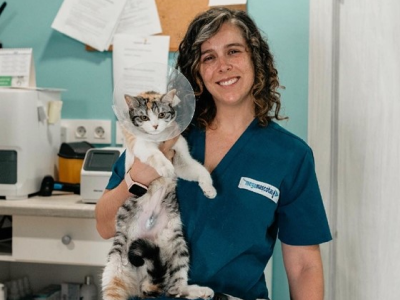QUESTION WITH OUR VETERINARIANS
Submit your Question
Answered Questions!
From Nadly of California What should I know about this new respiratory illness spreading in dogs recently
The Atypical Canine Infectious Respiratory Disease Complex (aCIRDC) is an emerging disease in dogs, first identified in the United States. Unlike typical CIRDC, aCIRDC is characterized by being difficult to treat and may present a range of more severe respiratory symptoms.
ORIGIN AND DEVELOPMENT OF ACIRDC
The origin of aCIRDC is not yet entirely clear. A single causal pathogen has not been identified, but researchers suspect a novel pathogen similar to Mycoplasma. This bacterium is unusual because it lacks a cell wall, a common feature in many bacteria. This finding comes from deep sequencing analysis conducted by Dr. David Needle’s team at the Hubbard Genomic Research Center at the University of New Hampshire, based on samples collected in various states. So far, they have analyzed several samples from sick dogs in different U.S. states, looking for genetic clues to help identify the causative agent.
SYMPTOMS AND IMPACT
The symptoms of aCIRDC are divided into three main clinical syndromes:
1) Mild to moderate chronic tracheobronchitis: This condition can last 6 to 8 weeks or more, with signs including coughing, sneezing, and serous or mucous ocular and nasal discharge.
2) Chronic pneumonia: Characterized by minimal response to antimicrobials, it may include respiratory difficulty (dyspnea) and, in some patients, systemic signs such as weakness, lethargy, or fever.
3) Acute pneumonia: This form can become severe quickly, and the animal may develop serious pneumonia that can worsen and lead to death within 24 to 36 hours, although this is less common.
These symptoms indicate a highly contagious disease that spreads rapidly among dogs in contact with other dogs. Dogs with aCIRDC can show various symptoms, including:
- Cough: A cough that can be dry or with mucus.
Sneezing. - Nasal and ocular discharge: You may notice that your dog’s eyes and nose are more “watery” or mucus-filled than usual.
- Fever, anorexia, lethargy: In more severe cases, your dog may have a fever, lose appetite, and be more tired or less active than usual.
- Difficulty breathing: In cases of pneumonia, breathing can be difficult and rapid.
- Symptom variability: Like in humans, some dogs may have mild symptoms while others can become seriously ill.
This depends on several factors, such as the dog’s age, overall health, and immune system. In summary, aCIRDC can present mildly as prolonged coughing or more seriously as pneumonia. It is important to be vigilant for these symptoms and consult a veterinarian if your dog shows signs of respiratory illness, especially if they persist or worsen.
AFFECTED DOG POPULATION
So far, there is no evidence that this disease can be transmitted to humans or other animals. It seems to be an issue exclusive to dogs, especially those in close contact with other dogs, such as in parks, dog daycares, grooming salons, and dog shows. It can affect dogs of any age and breed. No specific predisposition based on breed or age of the dog has been identified.
DIAGNOSIS
Diagnosing aCIRDC can be challenging. Respiratory PCR panels can rule out known respiratory pathogens, but additional testing may be necessary to identify the causative agent of aCIRDC. It is recommended to collect samples for PCR within 4 days after the appearance of the first clinical signs. It is important for dog owners to be aware of these risks and closely monitor their pets for signs of respiratory illness, especially after being in these environments. The first step is to observe your dog’s symptoms. If they have persistent coughing, difficulty breathing, nasal or eye discharge, or if they seem more tired or have no appetite, these may be signs of aCIRDC. Therefore, diagnosing aCIRDC involves carefully observing symptoms, conducting a thorough veterinary examination, and possibly conducting laboratory tests such as PCR tests and DNA sequencing. It is a process that requires a veterinarian’s expertise and, in some cases, specialized tests.
TREATMENT
Treatment for the Atypical Canine Infectious Respiratory Disease Complex (aCIRDC) primarily focuses on alleviating symptoms and supporting the dog’s immune system to fight the disease, such as:
• Cough suppressants: If the cough is dry and unproductive, medications can be used to help soothe it and make your dog more comfortable.
• Saline nebulization: This involves using steam or mist to help open the airways and make breathing easier.
• Oxygen therapy: In more severe cases, especially if the dog has difficulty breathing, supplemental oxygen may be needed.
• Antibiotics: If a bacterial cause is suspected or identified, antibiotics may be prescribed. However, since the specific pathogen of aCIRDC is still unclear, the use of antibiotics should be carefully considered by the veterinarian.
• Hospitalization in severe cases: For dogs with severe symptoms, such as acute pneumonia or significant respiratory difficulty, hospitalization may be necessary. This allows for intensive monitoring and treatment, which can include intravenous fluids and ventilatory support. WHAT CAN OWNERS DO AT HOME? To care for a dog with Atypical Canine Infectious Respiratory Disease Complex (aCIRDC) at home, in addition to the medical treatment prescribed by a veterinarian, there are several care measures and precautions you can take:
• Quiet environment: Keep your dog in a comfortable and quiet place to facilitate rest and recovery.
• Good hydration: Ensure constant access to fresh water to stay well-hydrated.
• Proper feeding: Offer a balanced and easy-to-digest diet. Consult with your veterinarian about the best diet during recovery.
• Limit physical activity: Avoid intense exercises or rough play. Short, gentle walks are preferable if your dog feels energetic.
• Careful monitoring: Closely observe your dog’s symptoms and any changes in behavior or appetite.
• Air humidification: If you live in a dry environment, using a humidifier can help ease your dog’s breathing.
• Owners should ensure they are up-to-date with all vaccines, such as those for Canine Influenza, Bordetella, and Parainfluenza.
• Reduce contact with a large number of unknown dogs. As with other respiratory pathogens, the more contact your dog has, the greater the risk of encountering a contagious dog. Avoid community drinking fountains shared by several dogs.
• Reduce contact with sick dogs. This can be more difficult to determine, but if a dog appears sick (cough, nasal discharge, watery eyes), keep your pet away. What owners should NOT do at home is:
• Self-medication: Never give your dog human medications or home remedies without veterinarian approval.
• Exposure to other dogs: Avoid taking your dog to places where they may come into contact with other dogs, such as parks or daycares, to prevent the spread of the disease.
• Ignoring severe symptoms: If your dog’s symptoms worsen or new symptoms appear, contact your veterinarian immediately.
• Sudden dietary changes: Do not make drastic changes to your dog’s diet without first consulting a professional.
• Overexerting your dog: Do not force your dog to engage in physical activities if they do not feel well.
CONCLUSION
The Atypical Canine Infectious Respiratory Disease Complex (aCIRDC) is a growing challenge in canine health. Although many details about this disease are still unknown, it is vital for owners to be alert to respiratory symptoms and seek timely veterinary care. Prevention is key, including reducing contact with other dogs and keeping vaccinations up to date. Treatment focuses on relieving symptoms and strengthening the immune system, with a special emphasis on home care and veterinary follow-up. Research is ongoing, and cooperation between veterinarians, researchers, and dog owners is essential to face this challenge, highlighting the importance of staying informed and following the guidance of veterinary health experts to protect our canine companions.

Lourdes Mª Arnedo Amat
(Veterinary Medicine)
I am Lourdes Mª Arnedo Amat and I have been passionately dedicated to veterinary medicine for 8 years. My professional career has been enriched with a specialization in Diagnostic Imaging in Small Animals, an area that has allowed me to delve deeper into the care and treatment of our smaller companions.
QUESTION FOR OUR VETERINARIANS” From Misty of Washington Why do some dogs scratch all the time? My mom’s dog scratches itself all the time but my dog barely ever scratches itself
Answer From Dr.Saba
How many of us have frequently seen our dogs struggling to scratch their skin with their hind paw? Or have you been hearing the collar tinkling off and on because of your dog’s neck-scratching behavior? It is normal in dogs to experience occasional itching; however, as a pet parent, it is crucial to recognize when itching is a serious concern and needs special care.
Most of the time, we mistake an itch as a normal behavior by our dogs who lick or chew on their paws. Many dog owners consider it a part of natural grooming, a habit, or a soothing activity. In fact, it may be an indication of some underlying allergies. Your dog can display an itch in various ways, like biting, scooting, scratching, chewing, and rubbing.
Allow me to help you understand the basic reasons for itching in dogs and tips to relieve your furlove from this discomfort.
How to tell if your dog has itchy skin?
Usually, itchy skin may be the result of several factors in dogs. The severity of the condition depends on the nature of the cause. Here are symptoms that may be evident, or some of them at least:
- Scaling of skin
- Uncontrolled scratching
- Constant licking
- Redness and infectious spots
- Biting of the specific area
- Bleeding (result of self-injury)
- Paw chewing
- Alopecia (hair loss)
- Oozing pustules
- Odor
- Lethargy
Understanding the different types of itchy conditions in dogs
There are several reasons for your dog to experience itchy skin. Some commonly observed conditions that result in itching are as follows:
Atopic dermatitis
A common skin condition that affects over 15% of the dog population. Such a type of dermatitis is characterized by inflammation and excessive skin itching. It could be seasonal or year-round and occurs in both acute and chronic forms. Golden Retrievers and Terriers are more predisposed to it.
Flea allergy dermatitis
Young dogs are susceptible to flea allergy dermatitis. You can see its symptoms at the base of your puppy’s tail more obviously. It occurs seasonally due to favorable weather conditions to support flea reproduction. Don’t confuse similar itchy conditions like scabies, ringworms, and mites with flea bites.
Food allergies
Your dog may exhibit itching due to food allergies. Some common food ingredients like chicken, beef, and dairy products might cause allergies in dogs. You may observe your dog having skin changes around the face, paws, belly, and armpits as an indication of food allergies.
Contact allergy
Any substance in your home could be a source of contact allergy for your dog. The common household shampoos, cleaners, insecticides, and even plants can be allergic to dogs. The contact parts of your dog’s body will experience itchiness and related symptoms.
Moreover, there could be other culprits for your dog’s itchy skin. It ranges from hypothyroidism, autoimmune diseases, tapeworms, mites, and many more.
Possible causes of itchy skin in your dog
One of the most commonly seen veterinary care conditions is pruritis or skin allergy. As a responsible pet parent, you want to figure out the exact cause of this complex problem. However, it is very difficult for a veterinarian to point out the exact cause as there are numerous of them out there:
- Mold
- Pollen
- Insect bites
- Bacterial skin infections
- Fleas, lice, mites, scabies
- Diet
- Hypothyroidism
- Hyperadrenocorticism
- Abnormal growths
- Immunity disorders
- Contagious (from other animals or pets)
How to diagnose itchy skin in dogs
As we know, itchy skin falls under a broad range of categories, and a proper history and diagnostic tests are necessary to make a possible diagnosis. You must be mindful of these questions before visiting your vet:
How long ago have you observed itchiness in your dog?
Is there any treatment for itchy skin going on? And what is the response?
What type of food you are feeding?
Is there any seasonal correlation?
What type of bathing and grooming products are you using?
Have you added a new pet to your home?
Does your dog take an interest in feeding and playing?
Have you seen any progression in skin condition?
Here, I mention some commonly used diagnostic tests to find out the possible cause of itchy skin in dogs. A vet can perform any of these tests to narrow down his/her diagnosis.
- Physical examination – Usually done to rule out fleas and lice
- Skin scraping – for mites
- Skin culture test – to find out the presence of bacterial or fungal infections
- Microscopy smear impression – in case of pustules from immune-related diseases
- Skin biopsy – to figure out any abnormal growths or neoplasia
- Blood test – It includes CBC and serum chemistry profile
- Fecal test – to rule out tapeworms
- Diet trial – if the suspect was a food allergy
What are the possible remedies for itchy skin for dogs?
Upon finding out the cause, it is necessary to implement appropriate remedies to treat itchy skin in dogs. Treatments vary depending on the nature of the cause.
Flea prevention
If your dog has itchy skin due to flea infestation, you can make use of vet-approved products to combat fleas.
Hypoallergic diet
It is beneficial for your dog to take hypoallergic diets in case of food allergies. You can make use of limited ingredients diets as trial up on a veterinarian recommendation.
Medicated shampoos
Depending on the diagnosis, you can buy antibacterial or antifungal shampoos to address skin infections in your dog. These products help to promote healing and soothe irritation.
Corticosteroids
Such a type of anti-inflammatory medication should only be used under professional guidelines in case of severe itching. Corticosteroids may impose potential side effects if misused.
Immunotherapy
Chronic allergic conditions in dogs need immunotherapy. It helps to reduce allergic reactions by desensitization of the immune system to specific allergens.
Antihistamines
Over-the-counter antihistamines can be used in case of mild itching. However, it would be better to provide proper dosage and type under professional supervision.
Omega-3 fatty acids
Supplementing your dog’s diet with omega-3 fatty acids would help to promote skin health. Fish oil is best to ensure these beneficial fatty acids to your dog.
Environmental management
Make sure to groom your dog on a regular basis. Moreover, ensure a neat and clean environment to minimize potential exposure to allergens.
Final thoughts
Itchy skin in dogs is a common issue with a number of causes that require serious consideration and professional guidance. You can contribute to your dog’s overall health by ensuring timely diagnosis and tailored treatments. Being responsible pet parents, we should be committed to making sure our furry fellows lead joyful and comfortable lives by understanding and addressing itching.

Dr Saba Afzal
(DVM, M.phil, RVMP)
Dr. Saba Afzal, DVM, M.Phil, RVMP, a distinguished clinical veterinarian and accomplished content writer. With a wealth of experience and expertise, Dr. Afzal is committed to sharing invaluable knowledge with pet owners worldwide.
It is supposed to be a hot summer and my dog is a husky with a double coat and I am worried he will get too hot or will get sick from the heat. He pants a lot when its warm and that makes me worry hes uncomfortable. My friend told me I should get him shaved because that will keep him cool but ive never seen a husky shaved before, would it help him stay cool? What types of things would you suggest for me to help keep him cool and comfortable during the summer? Thank you. Amy from Washington
Dogs pant for many reasons. Most of the time its normal for a dog to pant. It is the way how
they regulate their body temperature. Unlike humans, who sweat from the sweat glands in
their skin to keep themselves cool, panting is dogs’ primary way of cooling off.
The mechanism behind panting is “convection”.
When the doggo rapidly inhales and exhales (panting), it allows air to flow over
the mucous membranes in its mouth and nose. The heat is dissipated by the evaporation of water on your dog’s tongue.
However, if your fido starts panting vigorously and excessively, then it may be a
sign of any underlying health condition, pain, or anxiety. You must consult your
nearby vet in such a case.
You should not usually have to worry if your dog is panting, as panting is a normal mechanism of regulating body temperature in dogs. However, excessive panting is a sign that your furry friend may be struggling with their breathing or dangerously overheating.
Dogs normally start panting when they’ve been playing for some time or when
they are excited. Excessive panting may also be due to your doggo being heavy or
obese. They may become exhausted or fatigued after a little walk in the park.
Usually, you don’t need to worry a lot in either condition.
In some cases, there may be an underlying health concern that needs to be
addressed ASAP, if a dog pants vigorously or excessively even in a resting state,
in moderate weather. There might be a breathing problem due to dyspnea
associated with trauma, heart conditions, respiratory distress, metabolic disorders, etc.
Does Shaving my Dog Make him Cooler in Summer?
Cutting or shaving your pets’ hair to provide a cooling effect may not prove
valuable during hot, humid summer weather. Your pet’s coat itself offers climate
control by maximizing airflow and protecting against the rays of the sun.
Some breeds like Golden and Labrador Retrievers, Huskies, Shiba Inu, etc. have a
double coat. The undercoat, which is the layer of hair closest to the skin, keeps
hot air from contacting the body. The furry coat also protects our furry friends
from sunburn and allergens.
Shaving or trimming our furry friends may lead to abnormal hair growth or hair growth in the form of patches in the future that may ruin the aesthetic look. So, shaving makes no difference and even makes it harder for your pet to regulate the body temperature during hot weather.
Keeping our furry friends cool in summer is very important for their well-being. Cutting their hair short or shaving the coat completely isn’t helpful at all. Better ways to keep your pets cool are: Providing Ample Supply of Fresh and Cool Water: Don’t take any chances- make sure to prioritize maximum water intake by ensuring access to fresh and cool water. Normally, our furry friends require 44-66ml water per kg body weight. During hot and humid weather, the daily water requirement is raised to 10% at over 30 degrees Celsius of climate temperature. The daily average water requirement may be doubled when dogs exercise at such a temperature.
Provide Shade or a Cool Spot to lie down: If your pet has free access to an open space, such as a lobby with no roof, and is very playful then you must provide a cool resting spot.
Offer Good Summer Treats: Everyone deserves some good summer treats in hot dry weather which not only replenishes the hydration status but also acts as a rich source of minerals. These treats contain some very useful ingredients like fruits (watermelon, mangoes, cucumber, strawberries, etc.), yogurt, etc.
Avoid Outdoor Activities on Hot Days: Rambling with your pet on a hot
summer day may lead to alarming conditions like sunburn and dehydration.
Especially when the temperature is above 30 degrees Celsius, it is advised to
keep your pets indoors and hydrated.

Daniyal Mukhtar
(UVAS)
Surgery and Medicine are my areas of interest because I think that early and accurate diagnosis at the start is key to an effective course of treatment and recovery. My love for animals motivates me to improve and polish my practical skills as well as gain as much experience on my journey to become the voice of the voiceless.
